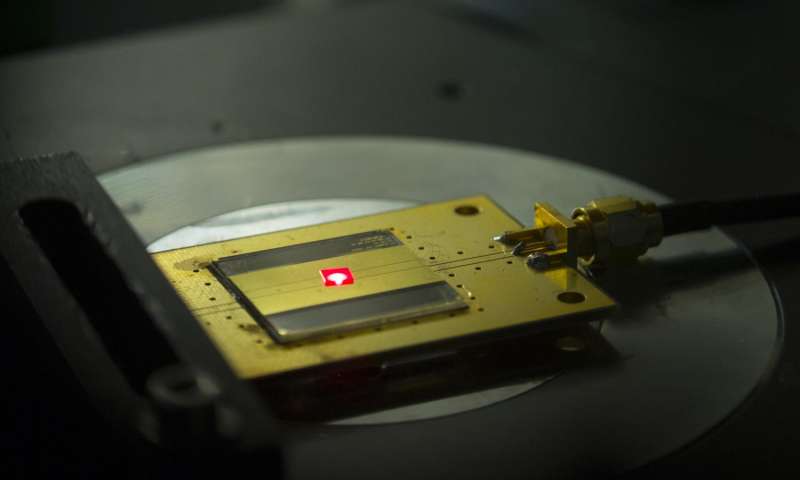Specialists from Harvard have created the smallest radio in the world from diamond

This radio is only the beginning of work, in the future, scientists plan to use other properties of diamonds to create miniature radio electronic elements.
Researchers at SEAS ( Harvard John A. Paulson School of Engineering and Applied Sciences ) created the smallest radio in the world of pink diamonds. More precisely, the role of the receiver is not played by the diamonds themselves, but by microscopically small defects in the crystal lattice the size of several atoms. The tiny radio itself is formed from blocks whose size is two atoms. Such a receiver can work in the most adverse conditions, when any electronic device simply fails. This may be the surface of Venus, the volcano's mouth. A similar system can be used in medicine - for example, using a similar module as a pacemaker.
Marko Lončar became the development team leader. He and his graduate student Linbo Shao proposed the idea of using point defects of diamonds, which are known as a nitrogen-substituted vacancy in a diamond. The defect itself is a violation of the structure of the diamond crystal lattice, which occurs when the carbon atom is removed from the lattice site and the resulting vacancy is bonded to the nitrogen atom.
The uniqueness of this defect lies in the fact that its properties are almost analogous to the properties of the atom, whether it is “frozen” in the diamond crystal lattice: the electronic spins of the individual center are easily manipulated: with light; magnetic, electric and microwave fields; - that allows you to record quantum information (qubits) on the back of the nucleus center. Such manipulation is possible even at room temperature; The center has a long (reaching several milliseconds) storage time of induced spin polarization ... At present, the NV center can be considered as the basic logic element of a future quantum processor, necessary for creating a quantum computer, communication lines with a quantum security protocol and other spintronics applications.
')
In order to create a nitrogen-substituted vacancy, the researchers replaced the carbon atom in a tiny diamond with a nitrogen atom, removing one of the neighboring atoms. As a result, a system was formed of a nitrogen atom and a “hole”. Jobs can be used to emit a single photon, or to detect a weak magnetic field. Systems of this type have photoluminescent properties, which means the ability to convert information into light. This opens up the possibility of using nitrogen-substituted vacancies in quantum computing, photonics, and other fields.
Even high-purity natural and synthetic (IIa-type) diamond contains a small concentration of NV-centers. (High-purity synthetic diamond is made using chemical vapor deposition (CVD)). If the concentration of the centers is insufficient, then the samples are irradiated and annealed. Irradiation is carried out by high-energy particles (10–80 keV); it can be a stream of: electrons, protons, neutrons and gamma particles. NV centers are created at a depth of 60 microns. Interestingly, NV0 mainly lie down to 0.2 μm depths. The created vacancies at room temperature are not mobile, however, with an increase in temperature (above 800 ° C), their mobility significantly increases. A nitrogen atom embedded in the lattice captures one of the vacancies and creates NV− with another neighboring vacancy.
As for radio receivers, they usually consist of five basic components: an energy source, a receiver, a transducer that converts electromagnetic waves into electrical current, a regulator and a speaker. The system created by experts from Harvard has all these components, although not in the form in which we are accustomed to see them.
The energy source here is a laser beam that is directed to electrons in nitrogen-substituted vacancies. Electrons are sensitive to the electromagnetic field, so that they react to radio waves when exposed to laser beams. When a vacancy detects a radio wave, it converts it to red light, which is redirected through a photodiode (in this case, it is a converter). He turns light into current. Further, the current is converted into sound using the speaker.
But what about setting up such a receiver? Scientists have also solved this problem. They have created a magnetic field around the diamond, which can be controlled to change the frequency of radio waves perceived by vacancies. The signal can be enhanced if you work with a large number of vacancies. SEAS researchers use billions of such point diamond defects. The system can work with one vacancy, but, unfortunately, in this case, you can emit only one photon at a time, instead of a stream of red light.
In the future, a team of researchers hopes to explore the possibility of working with other atomic defects, for example, silicon vacancies in diamonds. Perhaps this will help better control the radio waves.
When conducting trial tests of a diamond radio receiver, scientists worked, including, in conditions of high temperature - about 350 degrees Celsius. “Diamonds have unique properties,” says the project manager. "This radio can work in space, in difficult conditions or in the human body."
The study was supported by the STC Center for Integrated Quantum Materials .
Source: https://habr.com/ru/post/400171/
All Articles